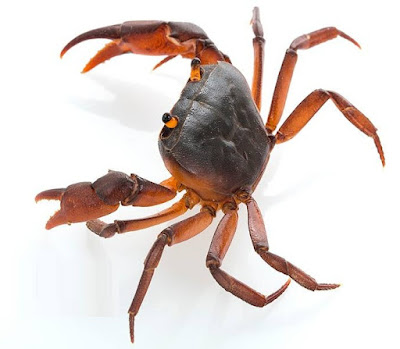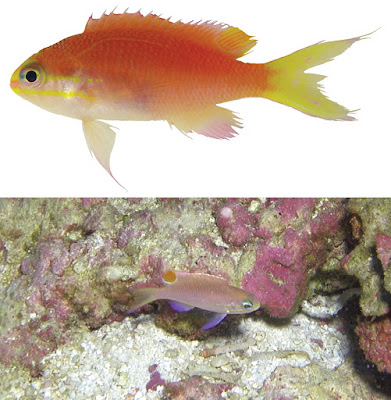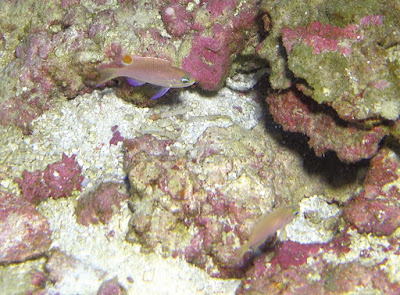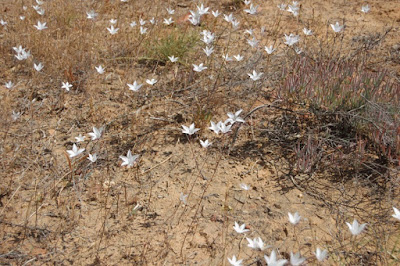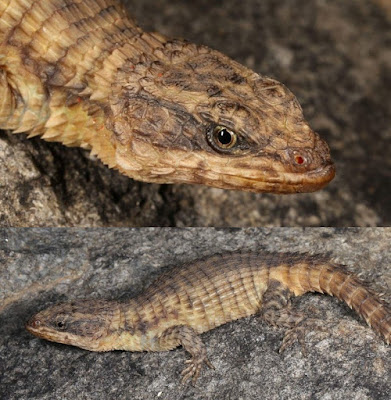[Most Recent Entries] [Calendar View]
Tuesday, December 27th, 2016
| Time | Event | ||||
| 12:30a | [Crustacea • 2016] Potamonautes gorongosa • A New Species of Potamonautid Freshwater Crab (Decapoda, Brachyura) from Mozambique, southeastern Africa
A new species of the freshwater crab genus Potamonautes MacLeay, 1838, is described from Gorongosa National Park in Sofala Province, Mozambique, southern Africa. Potamonautes gorongosa, new species, is morphologically and phylogenetically distinct from the other species of Potamonautes found in Mozambique and nearby countries, and is most closely related to Potamonautes mutareensis Phiri and Daniels, 2013, from eastern Zimbabwe. The new species differs from this species and its other congeners by a unique combination of morphological characters of the first gonopod, the anterior sternum, third maxilliped, and the major cheliped. Illustrations of P. gorongosa new species are provided, and differences with other species found in Mozambique and southeastern Africa are discussed. Keywords: Afrotropical region; Gorongosa National Park; Potamonautidae; taxonomy. Taxonomy Family Potamonautidae Bott, 1970 Genus Potamonautes MacLeay, 1838 Potamonautes gorongosa new species Potamonautes sp. 2 - Daniels et al., 2015: Pg. 553, Table 1; Pg. 558, Fig. 2. Etymology. The new species is named for Gorongosa National Park in Mozambique, the only place that it is known to occur (so far). Distribution. Potamonautes gorongosa, new species, is known from one locality in Gorongosa National Park in Mozambique. This is a 4,000 km2 park at the southern end of the Rift Valley in central Mozambique, and includes Mount Gorongosa (1,863 m asl) where P. gorongosa was collected. The Gorongosa National Park dominates the Gorongosa District in Sofala Province of Mozambique. Habitat. The freshwater crabs reported on in the present study were collected by the second author from Sofala Province in Mozambique, in highland and montane fresh waters where the vegetation type is predominantly savanna with fast-flowing mountain streams and rivers. This narrow 450 km long area lies within the Eastern Zimbabwe Highlands ecoregion in southeastern Africa along the eastern border of Zimbabwe with Mozambique and includes the Nyanga and Chimanimani mountains whose rivers drain eastwards through Mozambique (Thieme et al., 2005; Abell et al., 2008). The known locality for P. gorongosa lies in the Zambezian lowveld freshwater ecoregion that comprises most of western and northern Mozambique and extends from south of the Zambezi delta in central Mozambique southwards to the Tugela River system in South Africa (Thieme et al., 2005; Abell et al., 2008). This species was collected with P. obesus a semi-terrestrial burrowing freshwater crab found in the coastal belt of eastern Africa from Kenya to Mozambique (Reed and Cumberlidge, 2004). The report of P. obesus from western Mozambique is a new record for this species in this part of the country. Neil Cumberlidge, Piotr Naskrecki and Savel R. Daniels. 2016. Potamonautes gorongosa, A New Species of Potamonautid Freshwater Crab (Decapoda, Brachyura) from Mozambique, southeastern Africa. Nauplius. 24, e2016029. DOI: 10.1590/2358-2936e2016029. | ||||
| 1:14a | [Ichthyology • 2016] Tosanoides obama • A New Basslet (Perciformes, Percoidei, Serranidae) from Deep Coral Reefs in the Northwestern Hawaiian Islands
Abstract The new species Tosanoides obama is described from two specimens collected at a depth of 90–92 m off Kure Atoll and Pearl and Hermes Atoll, Northwestern Hawaiian Islands. It differs from the other two species of this genus in life color and in certain morphological characters, such as number of pored lateral-line scales, pectoral-fin rays, snout length, anterior three dorsal-fin spine lengths, dorsal-fin profile, and other characters. There are also substantial genetic differences from the other two species of Tosanoides (d ≈ 0.10 in mtDNA cytochrome oxidase I). The species is presently known only from the Northwestern Hawaiian Islands within the Papahānaumokuākea Marine National Monument. Keywords: Mesophotic Coral Ecosystem, Closed-Circuit Rebreather, Endemic, Papahānaumokuākea Marine National Monument, President Obama
Diagnosis: A species of Tosanoides (sensu Katayama & Masuda, 1980) distinguished by the following combination of characters: fourth or fifth dorsal spine the longest, dorsal-fin soft rays 17; anal-fin soft rays 8; pored lateral-line scales 33 or 34; head 2.9–3.0 in SL; body depth 2.8–2.9 in SL; color in life pink or yellowish pink on head and body, slightly darker dorsally fading ventrally; snout and region immediately dorsal to eye bright yellow, with a thin bright yellow band extending dorsally on either side of nape; a thin bright yellow horizontal stripe extending horizontally from posterior middle edge of eye posteriorly across most of operculum, continuing as a series of irregular oblong spots on midline of body from just posterior to gill opening to a point approximately one-fourth to one-half of pectoral fin; a second thin bright yellow stripe extending posteriorly from lower jaw across maxilla just ventral to eye and continuing horizontally across operculum and base of pectoral fin; dorsal fin pink or yellowish pink with darker pink regions on membranes, and a bright magenta margin extending from tip of first dorsal fin posteriorly on anterior half of soft dorsal fin; males with a large circular ocellate spot covering posterior one-third of soft dorsal fin, bluish magenta on perimeter and dark red with faint yellow stripes centrally; anal and pelvic fins magenta or yellow; caudal fin translucent yellow, more pale and translucent medially and distally, with bright magenta margins extending along margins of both lobes. Etymology: We name this species obama (a noun in apposition) in honor of Barack H. Obama, 44th President of the United States, in recognition of his efforts to protect and preserve the natural environment, particularly through his decision to expand the Papahānaumokuākea Marine National Monument several weeks after the discovery of this new species. Discussion Tosanoides obama is another example of several new fish species that have been discovered on deep coral reefs over the past several decades, mostly involving the use of modern mixed-gas closed-circuit rebreather diving technology (Pyle 1996, 2000). In recent years there has been increased attention focused on mesophotic coral ecosystems (MCEs), coral-reef habitat at depths of approximately 30–150 m in tropical regions worldwide (Hinderstein et al. 2010, Baker et al. 2016). Many more new species of fishes and other reef-associated marine organisms are likely to be discovered as a result of continued exploratory work in this poorly documented environment. The fish subfamily Anthiinae (Anthiadides Poey, 1861, type genus Anthias Bloch, 1792, stem Anthi-), is a homonym of the beetle subfamily Anthiinae (Anthies Bonelli, 1813, type genus Anthia Weber, 1801, stem Anthi-). According to Article 55.3 of the International Code of Zoological Nomenclature (ICZN 1999), homonymous family-group names in current use based on similar (but not identical) genus-group names must be referred to the Commission for a ruling to remove homonymy. A case is currently in preparation to formally resolve this homonymy through application to the ICZN. Until an Opinion is issued, we follow van der Laan et al. (2014, 2016) and Carvalho-Filho (2016) in using the spelling “Anthiadinae” to represent the subfamily for this new species, instead of the more commonly used (but homonymous) spelling “Anthiinae”. Richard L. Pyle, Brian D. Greene and Randall K. Kosaki. 2016. Tosanoides obama, A New Basslet (Perciformes, Percoidei, Serranidae) from Deep Coral Reefs in the Northwestern Hawaiian Islands. ZooKeys 641: 165-181. DOI: 10.3897/zookeys.641.11500 | ||||
| 1:22a | [Herpetology • 2016] Redescription and Range Extension of Microhyla sholigari Dutta & Ray (Anura: Microhylidae) from South West India
Abstract Microhyla sholigari is an endangered frog described in the year 2000. The original description was based on non-adult types and lacked information on several morphological characters, call structure, genetic material and photographs of the animal in life. The absence of such information posed challenges in field identification of this species. Since the original description, there is one other reported sighting of this species from Kerala in 2001. We encountered specimens that we confer to this species based on morphological similarity to the subadult holotype, from several new localities within and outside the Western Ghats of Karnataka. We here redescribe the species based on additional adult vouchers, provide molecular data, describe the advertisement call and report a range extension. Based on its current distribution, we assess the threat status of the species and suggest listing it as Least Concern according to IUCN Red List criteria. Our paper bridges an important gap in the knowledge of the genus Microhyla in India and highlights the importance of systematic surveys in documenting and understanding amphibian diversity in the region. Keywords: Amphibia, IUCN Red List; range extension; Western Ghats, acoustics; morphology, integrative taxonomy Seshadri, K. S., H. Priti, G. Ravikanth, M. K. Vidisha, K. K. Vineeth, Ramit Singal, R. R. Sarma, N. A. Aravind and Kotambylu V. Gururaja. 2016. Redescription and Range Extension of Microhyla sholigari Dutta & Ray (Amphibia: Anura: Microhylidae) from South West India. Zootaxa. 4208(6); 547–560. DOI: 10.11646/zootaxa.4208.6.3 | ||||
| 1:56a | [Botany • 2016] Kericodon (Campanulaceae s.s.), A New Monotypic Wahlenbergioid Genus from South Africa
Summary Evidence is presented to support the exclusion of Prismatocarpus crispus from Prismatocarpus and placing it in a new monotypic genus, Kericodon. It is distinct from Prismatocarpus in its annual growth form, three or rarely two or four pairs of style glands, capsule dehiscence via numerous longitudinal segments not corresponding to the calyx lobes, pericarp sclerenchyma arranged in discrete bundles and a rugose-like Type 1E seed coat sculpturing pattern. The closely related P. hildebrandtii is placed in synonymy with Kericodon crispus. Key Words: New taxon; pericarp anatomy; Prismatocarpus crispus; seed coat; Wahlenbergia; Western Cape Kericodon Cupido gen. nov. Type: Kericodon crispus (L’Hér.) Cupido Etymology. The name, Kericodon, is derived from Greek, keri = candle and codon = bell. It refers to the general appearance of the flowering plants in the field, resembling candles in a candlestick. Christopher N. Cupido and Frans M. Weitz. 2016. Kericodon (Campanulaceae s.s.), A New Monotypic Wahlenbergioid Genus from South Africa. Kew Bulletin. 71(4); 56. DOI: 10.1007/s12225-016-9671-4 | ||||
| 3:22a | [Arachnida • 2016] Revision of the Australian Union-Jack Wolf Spiders, Genus Tasmanicosa (Araneae, Lycosidae, Lycosinae)
Abstract The Australian wolf spider (Lycosidae Sundevall, 1833) genus Tasmanicosa Roewer, 1959 with Lycosa tasmanica Hogg, 1905 as type species is revised to include 14 species: T. godeffroyi (L. Koch, 1865), comb. nov. (= Lycosa tasmanica Hogg, 1905, syn. nov.; = Lycosa zualella Strand, 1907, syn. nov.; = Lycosa woodwardi Simon, 1909, syn. nov.); T. fulgor sp. nov.; T. gilberta (Hogg, 1905) comb. nov.; T. harmsi sp. nov.; T. hughjackmani sp. nov.; T. kochorum sp. nov.; T. leuckartii (Thorell, 1870), comb. nov. (= Lycosa molyneuxi Hogg, 1905, syn. nov.); T. musgravei (McKay, 1974) comb. nov.; T. phyllis (Hogg, 1905) comb. nov. (= Lycosa stirlingae Hogg, 1905, syn. nov.); T. ramosa (L. Koch, 1877), comb. nov.; T. salmo sp. nov.; T. semicincta (L. Koch, 1877) comb. nov.; T. stella sp. nov.; and T. subrufa (Karsch, 1878) comb. nov. Within the Australian wolf spider fauna, the genus Tasmanicosa can be diagnosed by the distinct pattern of radiating light and dark lines forming a “Union-Jack” pattern on the carapace. Male pedipalp morphology identifies the genus as part of the subfamily Lycosinae Sundevall, 1833 due to the presence of a transverse tegular apophysis with dorsal groove guiding the embolus during copulation. However, genital morphology is variable and a synapomorphy based on male pedipalp or female epigyne morphology could not be identified. Members of Tasmanicosa are comparatively large spiders (body length ca. 12–30 mm), that build a shallow burrow, which is sometimes covered with a flimsy trapdoor. Species of Tasmanicosa are largely a Bassian faunal element with preference for open woodlands and/or floodplains, although some species can be found into the semi-arid Australian interior. Two Australian wolf spider species may represent Tasmanicosa based on their original descriptions, but due to immature types in combination with the somatic similarities of all Tasmanicosa species, cannot be identified with certainty. They are therefore considered nomina dubia: Lycosa excusor L. Koch, 1867 and Lycosa infensa L. Koch, 1877. The type species of Orthocosa Roewer, 1960 is transferred to Tasmanicosa; however, in order to prevent some non-Australian wolf spiders in the genus Orthocosa to be transferred into Tasmanicosa, which is considered endemic to Australia, we here place these species into more appropriate genera based on their original descriptions pending a future revision of these species: Arctosa ambigua Denis, 1947 comb. reval.; Alopecosa orophila (Thorell, 1887) comb. nov.; Hygrolycosa tokinagai Saito, 1936 comb. reval. Orthocosa sternomaculata (Mello-Leitão, 1943) is considered a junior synonym of Hogna birabeni (Mello-Leitão, 1943) comb. nov. Keywords: Araneae, taxonomy, systematics, Orthocosa, synonymy Framenau, Volker W. and Barbara C. Baehr. 2016. Revision of the Australian Union-Jack Wolf Spiders, Genus Tasmanicosa (Araneae, Lycosidae, Lycosinae). Zootaxa. 4213(1); 1–82. DOI: 10.11646/zootaxa.4213.1.1 | ||||
| 5:47p | [Herpetology • 2016] Cordylus namakuiyus • A Review of Cordylus machadoi (Squamata: Cordylidae) in southwestern Angola, with the Description of A New Species from the Pro-Namib Desert
Abstract The girdled lizard genus Cordylus is represented in Angola by two species, Cordylus angolensis and C. machadoi, separated from their nearest congeners by over 700 km. Here we describe a new species, Cordylus namakuiyus sp. nov., endemic to the arid lowlands west of the southern Angolan escarpment. Phylogenetic analysis using three mitochondrial and eight nuclear genes shows that the low-elevation forms and the proximate, high-elevation species C. machadoi are genetically divergent and reciprocally monophyletic, and together form the earliest diverging lineage of the northern Cordylus clade. Morphological data, collected using computed tomography and traditional techniques (scalation and morphology), identify consistent phenotypic differences between these high- and low-elevation species and allows for a detailed description of the osteology and osteodermal arrangements of the new species. A series of 50 specimens, collected during the 1925 Vernay expedition to southwestern Angola and housed at the American Museum of Natural History, are assigned to the new species, although the identity of Cordylus from northern Namibia remains ambiguous and requires further investigation. Keywords: Reptilia, computed tomography, girdled lizard, Kaokoveld, molecular phylogeny, ontogeny, osteoderms, osteology   Etymology. The specific epithet “namakuiyus” is the masculine latinised form of namakuiya, which means “thorny” in the Herero language, referring to the sharp spines on the limbs and tail of this species. Suggested common name: Kaokoveld Girdled Lizard. Distribution. Currently, the new species is known only from the south and central parts of Namibe Province, Angola, southwest of the Leba escarpment, at elevations of 215–509 m a.s.l. Habitat and natural history notes. This species is found in gently sloping crevices of granite outcrops in the arid Kaokoveld. When approached, specimens retreat into their fissure as far as possible, wedging themselves head-first and protecting their head and flanks with their spiny tails. As with all other cordylines, Cordylus namakuiyus sp. nov. is viviparous; the holotype contained two large fetuses (SVL 49.5% of the holotype). The fetuses appear to be approaching full-term, suggesting a spring/early summer parturition period. Although these fetuses lack any body osteoderms, the slightly larger neonates (SVL 55.6–56.4% of the holotype) possess significant dermal ossification, suggesting that the young rapidly accumulate osteodermal armour following parturition. One of the Pico Azevedo specimens was found occupying the same rock crack as an adult Chondrodactylus pulitzerae (Schmidt), and PEM R18005 from Iona National Park inhabited the same crack as an adult Chondrodactylus fitzsimonsi (Loveridge). Stanley, Edward L., Luis M. P. Ceríaco, Suzana Bandeira, Hilaria Valerio, Michael F. Bates and William R. Branch. 2016. A Review of Cordylus machadoi (Squamata: Cordylidae) in southwestern Angola, with the Description of A New Species from the Pro-Namib Desert. Zootaxa. 4061(3): 201–226. DOI: 10.11646/zootaxa.4061.3.1    |
| << Previous Day |
2016/12/27 [Calendar] |
Next Day >> |
